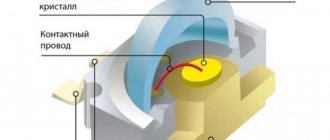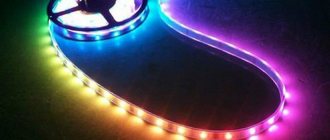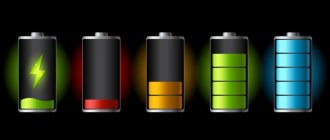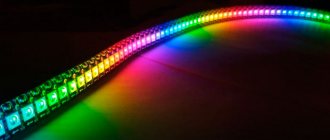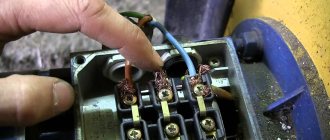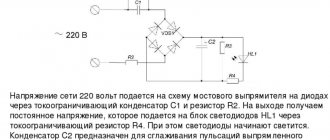The blinking light signal is widely used - from a special mode of operation of flashlights to the indication of complex equipment. It is increasingly based on a flashing LED, as a reliable and durable alternative to any other types of light sources.
Let's consider what its principle of operation is, what ready-made solutions for such a device are available on the market today, how to make an ice element operating in normal mode begin to work in a flickering rhythm, what is the general scope of their application, as well as how to do it yourself using them make garlands and running lights.
Operating principle
An LED with flashing light emission is a standard LED crystal, the electrical power circuit of which includes a capacitance and a resistor that determine the operating mode. Externally, it is no different from ordinary analogues. In this case, the mechanism of its operation at the level of processes occurring in the electrical circuit comes down to the following:
- When current is applied to resistor R, charge and voltage accumulate in capacitor C.
- When its potential reaches 12 volts, a breakdown is formed at the pn boundary in the transistor. This increases conductivity, which initiates the production of light flux by the ice crystal.
- When the voltage drops, the transistor becomes off again and the process begins again.
All modules of such a circuit operate at the same frequency.
Easy way
Using this method, it will be possible to create a structure with a voltage of 3 to 12 volts. How to make a flashing LED yourself is described below. The following components will be required for assembly:
- Resistor 6.8 – 15 Ohm (2 pcs).
- Resistors with a resistance of 470 - 680 Ohms (2 pcs).
- Low-power transistors with “npn” structure (2 pcs).
- Electric capacitors with a capacity of 47 – 100 µF (2 pcs).
- Low-power LED, color does not matter (1 pc).
- Soldering iron, solder and flux.
Let us remind you that before starting work it is recommended to clean the terminals of all radio components and then tin them. Do not forget about the polarity of electrolytic capacitors. Below is a diagram of the connection of all the above components. Having created the correct design, the voltage on R2 will stop reaching T2, at this time T3 and R1 will remain open, it is through them that the current will pass and reach the LED. Due to the fact that the current is supplied cyclically, the LED will blink.
Three red LEDs.
Flashing LED
To create this model you will need all the above components, as well as one regular AA battery. Below is a basic assembly diagram. This connection system has several capacitor charging chains - these are R1C1R2 and R3C2R2. After C1 and C2 have the required charge, they open, the second capacitor is connected to the battery. Their total voltage passes through T2 and penetrates the LED, due to this it begins to glow, as soon as the voltage disappears it goes out, and C1 and C2 lose energy. As soon as the voltage returns to them, a new cycle of current is supplied to the LED, and it begins to glow again. Thus, using a battery and a little knowledge of physics, you can create a blinking LED at home.
Creating a blinking LED.
Flasher
Looking at this diagram, anyone with even a little understanding of mechanics will immediately find two errors. The first is that the emitter and collector are not connected correctly, but the second is a “hanging” base. Despite two technical features, the LED will work. The connection point KT315 serves as a dinistor, due to the fact that a lot of voltage accumulates in it, it transfers it to the transistor, and it, in turn, opens. Then the current is directed to the LED and the light occurs. As the tension subsides, it fades away. Then everything happens cyclically. The table shows the main parameters of commercially produced MSDs, taken from the Internet Datasheet files.
Table of the main parameters of commercially produced flashing LEDs.
This article shows several methods for creating blinking LEDs. Thanks to this, you can easily repair your child’s toy, lighting in the house and New Year’s garland. Having deepened your knowledge of technology, the creation of LEDs can be used in other mechanisms, for example, in developing a light signal when the refrigerator door is opened or not completely closed; if it is dark in the entrance, then such a flashing design will help guests find the bell or switch.
It will be interesting Connection diagram for a pass-through two-key switch
Advanced technicians can create a bicycle turn signal that will help pedestrians know which direction the vehicle will be moving. In general, there are a huge number of places to use blinking LEDs. To use them you need basic knowledge, the necessary materials and skillful hands!
Ready flashing LEDs
Flashing LEDs from various manufacturers are essentially functionally complete circuits, ready for use in various fields. In terms of external parameters, they are not much different from standard ice devices. However, their design includes a generator-type circuit and its accompanying elements.
Among the main advantages of ready-made flashing LEDs are:
- Compact, robust housing, all components in one housing.
- Large range of supply voltage.
- Multi-color design, wide variety of shade switching rhythms.
- Economical.
Advice! The simplest flashing LED can be made by connecting an LED crystal, a CR battery and a 160-230 Ohm resistor into one chain, observing the polarity rules.
Usage patterns
The simplest version of the circuit of LED-based flashers produced today, which can be manufactured by radio amateurs on their own, includes:
- Low power transistor.
- Polar type capacitor 16 volts and 470 microfarads.
- Resistor.
- Ice element.
When the charge accumulates, an avalanche-like breakdown occurs with the opening of the transistor module and the glow of the diode. This type of device is often used in Christmas tree garland. The disadvantage of the circuit is the need to use a special power source.
Transistor flashers
The simplest option is an LED flasher on a single transistor. From the diagram you can see that the base of the transistor is hanging in the air. This non-standard inclusion allows it to work as a dinistor.
LED flasher on one transistor
When the threshold value is reached, a breakdown of the structure occurs, the transistor opens and the capacitor discharges to the LED. Such a simple transistor flasher can be used in everyday life, for example, in a small Christmas tree garland. To manufacture it you will need quite accessible and inexpensive radioelements. A DIY LED flasher will add a little charm to the fluffy New Year's beauty.
You can assemble a similar device using two transistors, taking parts from any radio equipment that has served its purpose. The flasher diagram is shown in the figure.
Multivibrator circuit with two transistors for a simple flasher
- resistor R = 6.8–15 kOhm – 2 pieces;
- resistor R = 470–680 Ohm – 2 pieces;
- NPN-type transistor KT315 B – 2 pieces;
- capacitor C = 47–100 µF – 2 pieces;
- low-power LED or LED strip.
Operating voltage range 3–12 volts. Any power source with these parameters will do. The blinking effect in this circuit is achieved by alternately charging and discharging the capacitors, which entails the opening of the transistors, as a result of which current appears and disappears in the LED circuit.
Flashing LEDs can be obtained by connecting the leads to several multi-colored elements. The built-in generator produces pulses for each color in turn. The frequency of the blinking pulse depends on the specified program. You can please your child with such a cheerful flashing if you install the device in a children's toy, for example, a car.
A good option would be if you take a three-color flashing LED that has four pins (one common anode or cathode and three color control pins).
Another simple option, for assembly you will need CR2032 batteries and a resistor with a resistance of 150 to 240 Ohms. A flashing LED will be obtained if all the elements in one circuit are connected in series, observing the polarity.
Flashing LED
If you can assemble funny lights according to the simplest scheme, you can move on to a more complex design.
LED flasher circuit
This LED flasher circuit works as follows: when voltage is applied to R1 and capacitor C1 is charged, the voltage across it increases. After it reaches 12 V, a breakdown of the pn junction of the transistor occurs, which increases the conductivity and causes the LED to glow. When the voltage drops, the transistor closes and the process starts over again. All units operate at approximately the same frequency, if you do not take into account a small error. An LED flasher circuit with five blocks can be assembled on a breadboard.
Transistor flasher layout
Source
Conventional LEDs
The standard non-blinking LED provides bright, uniform illumination and low power consumption. Along with such qualities as durability, compactness, energy efficiency and a wide range of glow temperatures, this makes it unrivaled among other artificial light sources. A circuit of flickering lamps is assembled on the basis of such LED elements. Let's look at the principle by which they are made.
How to make LEDs blink
An LED flasher can be assembled based on one of the above presented circuits. Accordingly, you will need to purchase the components described above. They are necessary for the functioning of one or another option. In this case, for assembly you will need a soldering iron, solder, flux and other necessary components for soldering.
The assembly of a chain of flashing LEDs is preceded by mandatory tinning of the output contacts of all connected elements. Also, we must not forget about observing polarity rules, especially when connecting capacitors. The finished lamp will flicker with a frequency of about 1.5 Hz or, which is the same, about 15 pulses every 10-second period of time.
Flasher circuits based on them
In order for elementary flashes of light to occur at a certain periodicity, a pair of C945 type transistors or analog elements is required. For the first option, the collector is placed in the center, and for the second, the base is located in the middle. One or a pair of flashing LEDs are manufactured according to the usual design. In this case, the frequency of flashes is set by the presence of capacitors C1 and C2 in the chain.
It is possible to simultaneously introduce several ice crystals into such a system when installing a sufficiently powerful PNP-type transistor. In this case, the LEDs are made to blink when their contacts are connected to multi-colored elements, the sequence of flashes is set by the generator module, and the frequency is set by the specified software settings.
Project “Migalka”
Let's try to make the project more complicated. Let's add two LEDs that will blink alternately.
You will need:
- Arduino Uno or Nano board
- Bread board
- Two 220 Ohm resistors
- Two LEDs. If possible, it is better to take blue and red.
- Wires for connection.
Difficulty: simple project.
What we will learn:
- How to connect an LED to Arduino.
- How to change the default flasher program.
- Let's repeat the procedure for loading the sketch into the microcontroller.
The connection principle does not change. We use two pins of the controller board to connect to the LEDs - 13 and 12. You can use the following circuit:
LED connection diagram for the Flasher project
We connect the positive contacts of the LED to the digital pins, the negative ones to GND.
Flasher programming
We will need to make certain changes to the sketch with the blinking LED. The algorithm of actions is as follows:
- Turn on the blue LED
- We wait for some time (1 second)
- Turn off the blue LED and turn on the red one at the same time
- We wait for some time (1 second)
- We repeat again
Try writing a program yourself, based on the experience gained from a previous project. If difficulties arise, you can refer to the example below.
// This block of commands is executed once void setup() { pinMode(13, OUTPUT); // These lines are needed to ensure that both LEDs glow brightly pinMode(12, OUTPUT); } // This block of commands is executed continuously void loop() { digitalWrite(13, HIGH); // Turn on the blue LED digitalWrite(12, LOW); // Turn off the red LED delay(1000); // Delay digitalWrite(13, LOW); // Turn off the blue LED digitalWrite(12, HIGH); // Turn on the red LED delay(1000); // Delay }
In this program we again encounter the loop command block. In it we turn pins on and off using digitalWrite. This shouldn't cause any difficulties.
Let's talk in more detail about the setup block. We saw it in the previous example. Inside setup there are usually initialization commands that are run only once, when the controller is connected to power.
In the examples with flashing lights, we set the pins to the desired mode - OUTPUT. In this mode, we work with external devices that receive power from this Arduino pin. For example, our LED does not transmit anything to the board; it uses pin 13 to turn on. Therefore, we set the OUTPUT mode - “to the output”. By default, all pins are in INPUT mode, which is optimal for connecting sensors. More detailed information can be found in the description of the pinMode function.
We hope that the procedure for checking the sketch and controller firmware did not cause any difficulties. Run the program and you will see how the LEDs on the board blink merrily. Congratulations on writing your first Arduino projects!
Application area
LEDs operating in a flashing rhythm are used in various fields:
- In the entertainment field, in toys, for decoration, as garlands.
- As an indication in household and industrial devices.
- Light signaling devices.
- In advertising elements, signs.
- Information boards.
Important! LEDs, which emit light in a blinking rhythm, are used not only in the visible range of the spectrum, but also in the infrared and ultraviolet segments. Their area of purpose is automation and remote control systems for various equipment - heating, ventilation, household appliances.
What is needed for production
You can buy a ready-made LED, which will start blinking when the supply voltage is applied. In such a device, in addition to the usual pn junction, there is a built-in electronic circuit made according to the following principle:
Flashing LED device.
The basis of the device is a master oscillator. It produces pulses with a relatively high frequency - several kilohertz or tens of kilohertz. The operating frequency is determined by the parameters of the RC chain. Capacitance and resistance are constructive - they are the elements of the LED device. In this way, it is not possible to obtain a larger capacity without significantly increasing the dimensions of the device. Therefore, the RC product is small, and operation at high frequencies is a necessary measure. At a frequency of several kilohertz, the human eye does not distinguish the blinking of the LED, and perceives it as a constant glow, so an additional element is introduced - a frequency divider. By sequential division it reduces the frequency to several hertz (depending on the supply voltage). In terms of weight and size, such a solution is more advantageous than using a capacitor with a large capacity. The lowest supply voltage for a finished flashing LED is about 3.5 volts.
How to make a garland of LEDs
To make a garland that periodically blinks with a given rhythm, you will need the following components and a set of tools:
- LEDs 20 mAh.
- Wiring with a cross-sectional area of 0.5-0.25 mm2.
- 6 volt transformer.
- 100 ohm resistor.
- Soldering station with a small section tip, solder, rosin.
- Knife with a sharp blade.
- Silicone based sealant.
- Felt pen.
Assembly algorithm:
- Determine exactly the spaces between the flashing elements.
- Prepare the wire and mark the LED marks with a felt-tip pen.
- At the marks, make cuts of the insulation with a sharp knife.
- Next, apply rosin and solder to the bare areas.
- Solder the diode electrodes to these places.
- Apply silicone sealant to exposed areas to provide electrical insulation.
Upon completion, connect the power supply and a regular resistor. The device is connected to the network and checked for functionality.
Advice! When making garlands, it must be taken into account that the exclusively sequential nature of the connection of LEDs in the circuit will provide their characteristic blinking effect.
Schematic diagram
If the only place of possible power supply is the electrical network, then you can connect the flashing LED according to the very well-proven circuit shown in the figure. Excess voltage drops across resistors R1-R3. There are three resistors of 75 kOhm, and not one of 220 kOhm, because it is advisable to make the line longer to ensure that breakdown is avoided. Diode VD1 serves as a rectifier. Capacitor C1 is storage. Now the most interesting thing is that the circuit contains a zener diode VD1. In principle, if the HL1 LED were not blinking, there would be no need for this zener diode, as well as for resistor R4.
But NI is a flashing LED. Therefore, at those moments in time when it goes out, its resistance increases greatly and, accordingly, the voltage dropping across it also increases. If there is no zener diode VD1, the forward voltage on the NI at the moment of its extinguishing will reach 300V and maybe even more. Which will lead to its failure. There is also a zener diode here that will limit the voltage on the LED at those moments when it is turned off.
The stabilization voltage of the zener diode does not necessarily have to be 12V. The zener diode can be of any voltage that the LED can normally withstand in the off state. But not lower than its direct voltage in the burning state. That is, somewhere from 3V to 30V. Almost any zener diode for any voltage within these limits. Accordingly, capacitor C1 must be at a voltage not lower than the voltage of the zener diode.
Resistor R4 is needed in order to limit the discharge current of the capacitor through the LED at the moment of its ignition. In principle, you can do without it, but there is a high probability that the LED will not last long. So R4 is here just in case. R4 is especially relevant when using a zener diode for voltage at the upper limit (up to 30V). Because the higher this voltage, the greater the current surge will be at the moment the LED lights up.
It will be interesting Tesla coil (Transformer) self-assembly on your own
Main conclusions
A flashing LED is a standard ice element, equipped with a resistor and capacitor for a specific rhythmic glow, operating on the following principle:
- The incoming current stores charge on the resistor.
- Upon reaching the specified potential, a breakdown occurs in the pn junction of the transistor - current flows and the LED flashes.
- As the charge decreases, the transistor turns off and the process repeats.
The circuit of a common flashing homemade LED may include one or a pair of transistors. When assembling them yourself, you need to prepare in advance all the necessary components and tools required during the work. The scope of application of flickering ice lamps is huge - from toys and garlands to alarms, indications and remote control systems.
If you know how to assemble a flashing LED circuit in another way, be sure to share useful information in the comments.
Previous
LEDsTypes and important characteristics of LED lamps for indoor lighting
Next
LEDs 12 V step-down transformer: how to choose and connect correctly
DIY alarm assembly
Having decided how flashing LEDs are designed, how they work, and why they flash, you can proceed directly to installation.
For assembly you will need 2 flexible stranded wires of small diameter. It is preferable to choose cables of different colors in order to be able to distinguish them when connecting to car wiring.
Next, you need to carefully insulate the solder joints when using regular or heat-shrinkable cambric.
Once the resistor and both wires are secured, you can place the circuit in a thick polymer tube. The final stage of installing the alarm yourself is connecting the wires to the “+” and “-” power circuits of the car. If everything flashes as it should, the LED flasher can be considered successful.
Assembling circuits with your own hands based on LEDs is very popular among car enthusiasts. Why? Diodes provide enormous opportunities for tuning. Replacement of any lighting, interior lighting and much more.
Service life of a repaired lamp
How long will such a light bulb with a “shunted” LED last?
Everything will depend on two factors. Firstly, what is the voltage in your network (normal, high (>230V) or low).
Secondly, where is this light bulb located? If this is a corridor, toilet, utility room, barn, etc., where it is turned on for a short time, then the lamp can easily last for several months.
If this is a living room, bedroom, kitchen, then we are talking about a much shorter period.
It is believed that the missing element will cause an increase in current in the entire circuit. Which is often what actually happens.
And this already leads to the sequential failure of the remaining LEDs one after another.
But if the driver in the lamp is made of high quality and has a good pulse current stabilizer, then the operation of the lamp will be maintained for a very long time.
Here is a visual comparison of the current strength in a “shunted” lamp...
and in a lamp, where instead of a burnt-out LED, several additional resistors were soldered in, which were precisely supposed to reduce the current.
As you can see, there is practically no difference. Do you think it’s worth bothering with this and worrying about a shorter service life?
But again, we repeat, this is only if you have a good driver.
With the classic cheap power supply circuit for an LED lamp using a quenching capacitor, the service life is reduced significantly.
Current stabilization in such lamps is very conditional.
Necessary materials and radio components
To assemble an LED flasher with your own hands, powered by a 12 V power source, you will need the following:
- soldering iron;
- rosin;
- solder;
- 1 kOhm resistor;
- capacitor with a capacity of 470-1000 μF at 16 V;
- transistor KT315 or its more modern analogue;
- classic LED;
- simple wire;
- 12V power supply;
- matchbox (optional).
The last component acts as a housing, although the circuit can be assembled without it. Alternatively, a circuit board can be used. The mounted mounting described below is recommended for beginner radio amateurs. This assembly method allows you to quickly navigate the circuit and do everything right the first time.
Repair by bypass
The easiest way to do this is with a drop of tin. Someone solders a thin wire here or even puts a piece of foil on it.
But all this is more complicated and less reliable.
Therefore, take a soldering iron, bring tin and drop it into the place where the LED used to be.
And if you don’t have a soldering iron at hand, what should you do in this case?
Take tin, which is sold as a thin wire on a spool, heat it with a “reactive” gas lighter and drop it onto the contact pad.
If you don't have a soldering iron or tin available, you can try adding a drop of conductive glue.
The entire repair with opening the lamp will take you no more than 5 minutes. To check the functionality, you don’t have to put the bulb in place, but just screw the light bulb into the socket and turn on the light.
You won't even notice much of a difference in the glow.


